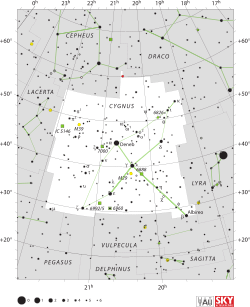Delta Cygni

| |
| Observation data Epoch J2000 Equinox J2000 | |
|---|---|
| Constellation | Cygnus |
| Right ascension | 19h 44m 58.47854s[1] |
| Declination | +45° 07′ 50.9161″[1] |
| Apparent magnitude (V) | 2.87[2] |
| Characteristics | |
| Spectral type | B9 III + F1 V[3] |
| U−B color index | –0.10[4] |
| B−V color index | –0.02[4] |
| Astrometry | |
| Radial velocity (Rv) | –20.1[5] km/s |
| Proper motion (μ) | RA: +44.07[1] mas/yr Dec.: +48.66[1] mas/yr |
| Parallax (π) | 19.77 ± 0.48[1] mas |
| Distance | 165 ± 4 ly (51 ± 1 pc) |
| Details | |
| Mass | 2.6[2] M☉ |
| Radius | 2.8[2] R☉ |
| Luminosity | 76[2] L☉ |
| Surface gravity (log g) | 3.95[2] cgs |
| Temperature | 10,120 ± 160[2] K |
| Rotational velocity (v sin i) | 135[6] km/s |
| Other designations | |
Delta Cygni (δ Cygni, δ Cyg) is the third-magnitude star in the constellation Cygnus. It will be the "North Star" for at least four centuries around 11,250.
This star belonged to the Arabic asterism al-Fawāris (الفوارس), meaning "the Riders" in indigenous Arabic.,[7] together with ζ, ε, and γ Cyg, the transverse of the Northern Cross.
In Chinese, 天津 (Tiān Jīn), meaning Celestial Ford, refers to an asterism consisting of δ Cygni, γ Cygni, 30 Cygni, α Cygni, ν Cygni, τ Cygni, υ Cygni, ζ Cygni and ε Cygni.[8] Consequently, δ Cygni itself is known as 天津二 (Tiān Jīn èr, English: the Second Star of Celestial Ford.)[9]
Features
Delta Cygni is a triple star; the system lies at a distance of about 170 light years and consists of two stars quite close together and one much farther out. This sort of common configuration lends stability.
The bright naked-eye star is a blue-white giant of spectral class B9,[3] with a temperature of 9,800 kelvins. It is nearing the end of its main-sequence life stage with a luminosity 180 times that of the Sun, a radius of 4.7 solar radii, and a mass approximately 3.15 solar masses. Like many hot stars, it spins rapidly, at least 135 kilometers per second at the equator, about 60 times that of the Sun. Its close companion is a yellow-white class F of the sixth magnitude (6.33) with a luminosity about 6 times that of the sun, and a mass about 1.5 times that of the sun. The much more distant third companion is an orange (class K) twelfth magnitude star, being only 38% as luminous as the sun, and only 70% as massive as the sun. As seen from Earth, the entire triple star system of Delta Cygni shines at a combined apparent magnitude of 2.86.
'North star'
It is one of eight bright stars in the northern hemisphere that lay claim to the position of "North Star" over the course of Earth's 26,000-year precession cycle.
The other seven stars are
- Tau Herculis (of Hercules),
- Vega (of Lyra),
- Alpha Cephei (of Cepheus),
- Gamma Cephei (of Cepheus),
- Polaris (of Ursa Minor),
- Kappa Draconis (of Draco), and
- Alpha Draconis (of Draco).
See also
References
- 1 2 3 4 5 van Leeuwen, F. (November 2007), "Validation of the new Hipparcos reduction", Astronomy and Astrophysics, 474 (2): 653–664, arXiv:0708.1752
 , Bibcode:2007A&A...474..653V, doi:10.1051/0004-6361:20078357
, Bibcode:2007A&A...474..653V, doi:10.1051/0004-6361:20078357 - 1 2 3 4 5 6 Malagnini, M. L.; Morossi, C. (November 1990), "Accurate absolute luminosities, effective temperatures, radii, masses and surface gravities for a selected sample of field stars", Astronomy and Astrophysics Supplement Series, 85 (3): 1015–1019, Bibcode:1990A&AS...85.1015M
- 1 2 Edwards, T. W. (April 1976), "MK classification for visual binary components", Astronomical Journal, 81: 245–249, Bibcode:1976AJ.....81..245E, doi:10.1086/111879
- 1 2 Johnson, H. L.; et al. (1966), "UBVRIJKL photometry of the bright stars", Communications of the Lunar and Planetary Laboratory, 4 (99), Bibcode:1966CoLPL...4...99J
- ↑ Evans, D. S. (June 20–24, 1966), Batten, Alan Henry; Heard, John Frederick, eds., The Revision of the General Catalogue of Radial Velocities, University of Toronto: International Astronomical Union, Bibcode:1967IAUS...30...57E
- ↑ Abt, Helmut A.; Levato, Hugo; Grosso, Monica (July 2002), "Rotational Velocities of B Stars", The Astrophysical Journal, 573 (1): 359–365, Bibcode:2002ApJ...573..359A, doi:10.1086/340590
- ↑ Allen, R. H., (1963). Star Names: Their Lore and Meaning (Reprint ed.). New York, NY: Dover Publications Inc. pp. 193, 197. ISBN 0-486-21079-0.
- ↑ (Chinese) 中國星座神話, written by 陳久金. Published by 台灣書房出版有限公司, 2005, ISBN 978-986-7332-25-7.
- ↑ (Chinese) AEEA (Activities of Exhibition and Education in Astronomy) 天文教育資訊網 2006 年 7 月 4 日
External links
- Marshall "Roc" Burns, My Nickname: The Mythological Roc - TheRoc.net
- James B. "Jim" Kaler, DELTA CYG (Delta Cygni) - STARS
- Alan M. MacRobert, Understanding Celestial Coordinates - Sky & Telescope
- Richard Powell, The Brightest Stars - An Atlas of The Universe